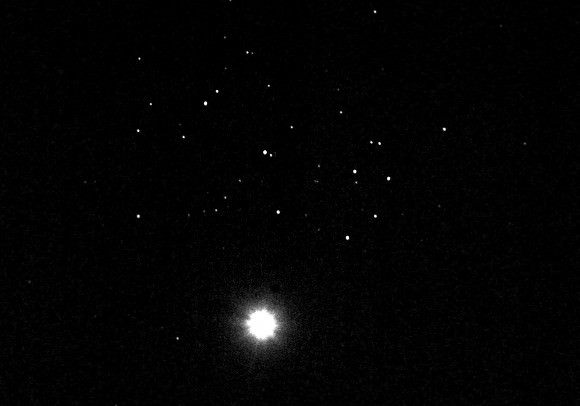The zodiac represents the constellations that the Sun passes through in its apparent path across Earth’s sky. Because the Sun (and the planets) are all on about the same plane in the Solar System, they pass through the same constellations and at times, can even eclipse each other.
While traditionally the zodiac is considered to have 12 constellations, technically the Sun passes through 13, according to this NASA page. In order, the constellations are Sagittarius, Capricornus, Aquarius, Pisces, Aries, Taurus, Gemini, Cancer, Leo, Virgo, Libra, Scorpius and Ophiuchus.
The reason there are now 13 constellations that the Sun passes through is that the axis of the Earth has changed over the millennia. Earth’s axis precesses or moves in a cycle that takes about 26,000 years. Over time, this means the direction of north has changed with respect to the sky. Vega was the North Star several thousand years ago, and will become it again in about 13,000 years, according to NASA. Today, the North Star is Polaris.

Because different cultures see different shapes in the stars of the sky, the number of constellations varied in ancient definitions of the zodiac. It has been used in cultures ranging from Greece to Babylon to China to India. It should also be noted that the constellations are of different size, so the Sun does not spend the same amount of time in each.
The number of constellations was fixed at 12 when mathematics was added to astronomy, according to Encyclopedia Britannica. While we don’t know when the symbols were first used, the first known instance is in Greek manuscripts used during the late Middle Ages, the encyclopedia added. Briefly, according to the encyclopedia, these are what each of the constellations are:
Aries (the ram), which has no bright stars and traditionally governs the period from March 21 to April 19. In Greek mythology, it represents the ran with the golden fleece. Phrixus sacrificed a ram to Zeus (the chief god) after safely fleeing Thessaly to Colchis on its back. Jason (the chief of the Argonauts) later recovered the fleece.

Taurus (the bull), whose brightest star Aldebaran is the 14th-brightest in the sky. Also in Taurus are two bright star clusters (the Pleiades and the Hyades) and the Crab Nebula. It traditionally governs April 20 to May 20. In Greek mythology, Taurus represents the bull form that Zeus (the chief god) took upon to abduct Europa.
Gemini (the twins), whose brightest stars are Castor and Pollux. It’s the current location of the northern summer solstice, when the Sun reaches its highest point in the sky. It traditionally represents May 21 to June 21. In Greek mythology, the twins were gods who “succored shipwrecked sailors and received sacrifices for favorable winds,” the encyclopedia stated.
Cancer (the crab), which also has no bright stars but contains a prominent star cluster known as the Beehive (Praesepe). It traditionally governs June 22 to July 22. In Greek mythology, it refers to a crab that was crushed after pinching Heracles while he was fighting a hydra. Hera (an enemy of Heracles) rewarded the crab by immortalizing it in the sky.

Leo (the lion), whose brightest star is Regulus — sometimes called the “little king.” It traditionally governs July 23 to August 22 and in Greek mythology, represents a lion that Heracles killed.
Virgo (the virgin), whose brightest star is Spica — the 15th-brightest seen in Earth’s sky. It’s also known for the Virgo cluster of galaxies and the pulsar PSR 1257+12, where astronomers found the first confirmed extrasolar planets in 1992. It traditionally represents August 23 to September 22 and in Greek mythology, is associated with the harvest maiden (Persephone).
Libra, which has no bright stars. It traditionally governs Sept. 22 to Oct. 23 and is associated with balance or justice, such as with the Roman goddess Astraea.
Scorpius, whose brightest star Antares is known as the “rival of Mars” due to its red color and similar appearance to the Red Planet. It also contains Scorpius X-1, the brightest X-ray source in the sky. It traditionally governs Oct. 24 to Nov. 21 and in Greek mythology, refers to one of two legends. The first is said to be a scorpion that killed Orion, and the second refers to one that spooked horses being controlled by Phaeton as the young man was trying to drive the Sun.

Sagittarius (the archer), which contains a prominent radio source known as Sagitarrius A. It is considered to govern Nov. 22 to Dec. 21, and is considered a mounted archer in several cultures (starting with the Babylonians in the 11th century).
Capricornus (the goat), which has no bright stars. It traditionally governs Dec. 22 to Jan. 19. In Greek mythology, it is associated with the god Pan. He leaped into the water to get away from a monster called Typhon, just as Pan was changing shape. This made him a goat with a fish tail.
Aquarius (the water bearer), which has no bright stars. It is considered to rule over Jan. 20 to Feb. 18 and is traditionally associated with a man pouring water out of a jug. The symbolism likely arises from the Middle East, whose astronomers noted that the constellation rises with the rainy season.
Pisces (the fish), which has no bright stars. It traditionally rules over Feb. 19 to March 20 and in Greek mythology, refers to Aphrodite and Eros. They went into a river to avoid a monster called Typhon. Some versions of the myth say they changed into fish, while others say they rode fish to get away.
Universe Today has articles on zodiac signs and their dates. Astronomy Cast also has an episode on constellations.

